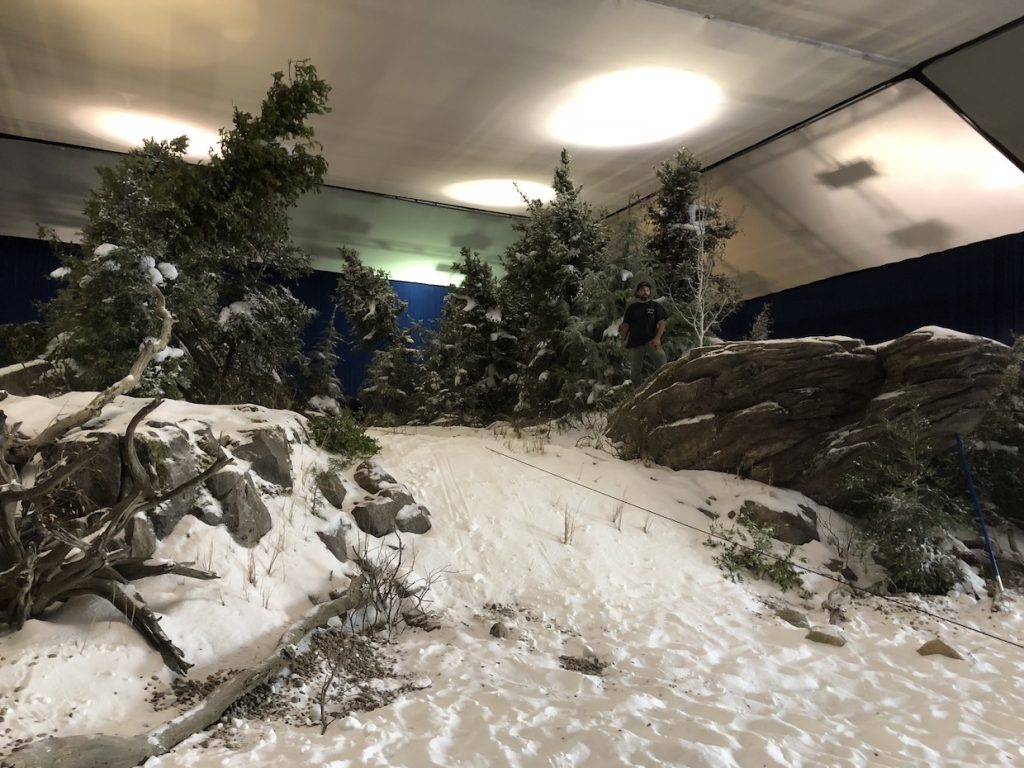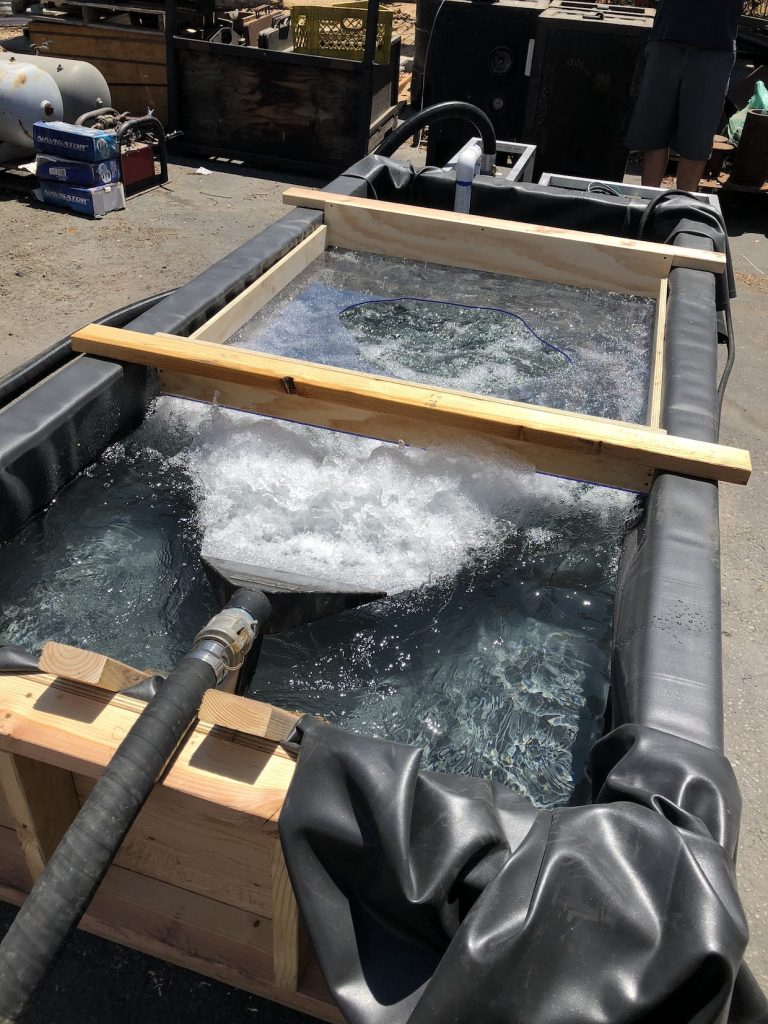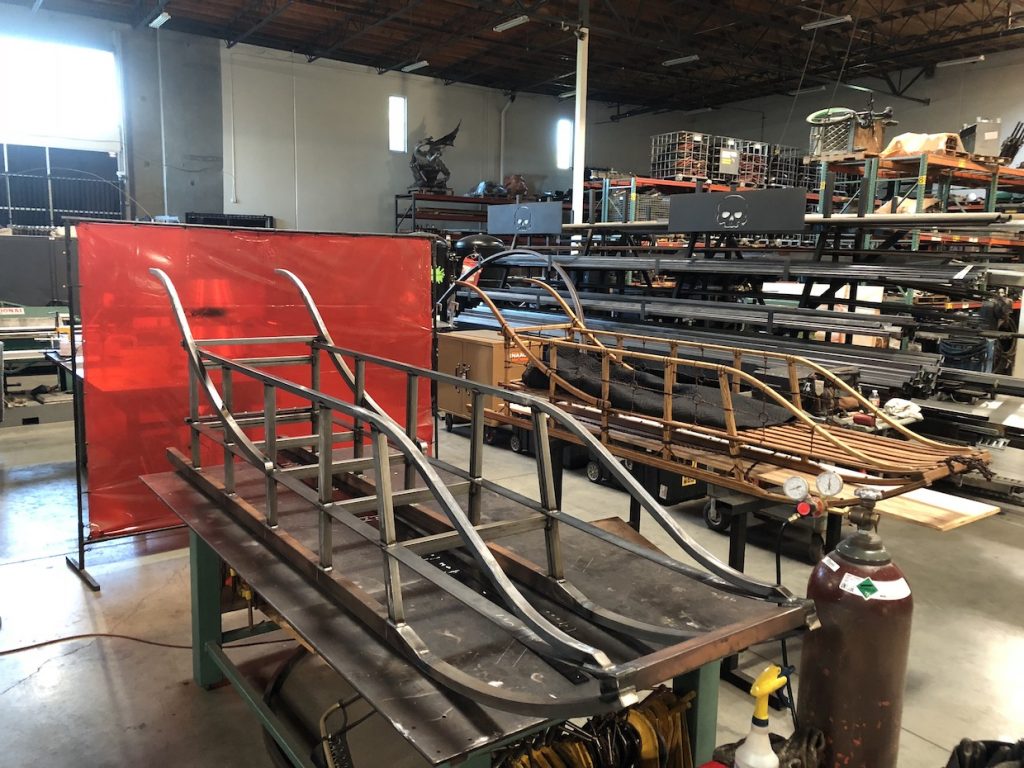 Back to selection
Back to selection
Special Effects Coordinator Jeremy Hays on The Call of the Wild, Once Upon a Time…in Hollywood’s Flamethrower and Working with Jackie Chan
 A snow set for The Call of the Wild
A snow set for The Call of the Wild General audiences most likely recognize special effects coordinator and technician Jeremy Hays from his memorable moment in Once Upon a Time… In Hollywood, where he informs Leonardo DiCaprio’s character, Rick Dalton, that they can’t cool the heat on his flamethrower because, well, it’s a flamethrower. Hays is a veteran who has worked in practical and special effects for over 25 years, frequently employing his skills on big-budget comedies. Last year, he contributed to some of the biggest films of the year: Once Upon a Time… in Hollywood, Dolemite Is My Name and Booksmart.
Most recently, Hays was the special effects supervisor on The Call of the Wild, an adaptation of Jack London’s classic novel that features extensive CGI, most prominently with Buck, the St. Bernard-Scotch Collie mixed breed dog that carries the film. Accordingly, Hays’ primary job was to create the environments that Buck moved through and facilitate believable movement with objects he interacted with, such as sleds, tables and beds.
“It’s kind of like imagining an Invisible Man movie,” he says. “You have to create all the stuff that the Invisible Man comes into contact within the real world. Integrating the digital and real parts together, and being able to do it in a fashion that looks believable, takes a bit of thought in order to understand how optics behave in the physical world and how it would work if it was motivated by a non-physical being. Those challenges are pretty much what’s enjoyable about the job. You get the opportunity to create things from nothing.”
I spoke to Hays about the unique challenges of working on The Call of the Wild, how his foreign language training in the army helped bring him into the effects industry, the various red tape that has to be surmounted to operate a flamethrower in the state of California and his time working with Jackie Chan.
Jeremy Hays: For a while, [Jackie Chan] did these V8 commercials—you know, the vegetable juice. There were six or seven comedy sketches within the commercials back in 2008 or 2009. I translated Chinese in the army before I got into this business, so we hit it off. He has choreographers that work with him, and some of his choreographers also worked on Charlie’s Angels (2000) with the stunt team that did The Matrix. I actually was hired on Charlie’s Angels as a stunt rigger and special effects guy because I knew Chinese, not because I knew effects, so that I could help work with the stunt team from Hong Kong. We knew mutual people, so when we worked on the V8 project, a rapport had already been established right off back.
Filmmaker: Was your Mandarin training helpful in breaking into the industry?
Hays: I’ll do this really quick. I went into the army. They said, “We’re going to teach you a foreign language.” I said, “Sure, whatever.” They gave me Mandarin Chinese. I did that for four-and-a-half years, loved it, then decided to get out of the military. I was going to go work for Motorola, back during the time when cell phones were just starting to become a big thing, but I didn’t have enough business experience. A guy I knew in Hollywood worked at a special effects house. They needed somebody to purchase for them during the Volcano, Dante’s Peak-era. He says, “You can just take the title as a purchasing manager”—even though it’s just me, one person, so then I can turn that into a spot on a resume and reapply at Motorola. I didn’t have intentions to stay in special effects, I just ended up here.
My grandfather did special effects from 1943 to 1971. I never really understood special effects in a filmmaking capacity, because I was really young before he passed away, but we always had a really great time going up to the ranch and doing stuff with his effects gear. I didn’t put the two together until I had been working in effects for about seven or eight months. I went up to Northern California to visit my grandmother after my grandfather passed away and walked into the barn, his shop, and started seeing all the effects-related equipment I had been using for the past half year. It dawned on me: he did special effects, my dad also worked in the effects business for a short time, and somehow I had fallen back into it. So I took that as a cue that maybe I should be doing this and I’ve stayed doing this ever since.
Filmmaker: Much of The Call of the Wild takes place in the wintry landscapes of Alaska and the Yukon but was shot in California. What was used to create all the snow on set?
Hays: Initially the project was going to be done mostly on stage, but once they realized that they were going to have more sizable locations, plus a lot of background extras and talent not generated in the computer, the scale of the sets got bigger. In the outdoor sets, there’s a lot of interaction between the talent and the snow, so we used a couple different products. Mostly we tried to create landscapes with chipped ice. Chipped ice is a process—we have a chipping machine, where you take big 300-lb blocks of ice, slide it down a chute and it comes out like Snow Cone ice.

In certain cases, we would use bags of Epson salts, magnesium sulfate, 40-pound bags we’d have to carry around and spread out to create a base of snow for the background. We’d also use a product called cellular snow, or vapor snow, which we’d shoot out of an insulation blower that really looks nice on ledges and trees, any kind of vegetation. A lot of the scenes in the movie were a combination of chipped ice, Epson Salts, vapor snow and a couple other products that were more specialized for icicles and frosting on the glass. On some of the scenes we shot on stage, we used a product called Display Snow, or Faux Snow, a plastic product that looks really close to, and behaves a bit like, powdered snow. There are a multitude of products that all act and behave differently used in different situations. When you’re outdoors, it has to be biodegradable and chemical-free so it won’t hurt the environment. If it’s on stage, it has to be fireproof.
Filmmaker: One of the biggest sequences in the film involves Buck saving someone who has fallen through ice. I assume this was created with tanks.
Hays: We basically had three tanks. One was the vertical section where Francoise [Cara Gee’s character] falls in, one purely for underwater photography, and then another section with a different tank for them coming out of the ice after Buck rescues Francoise. Two of the tanks were long rectangular tanks so we can create current and flow in the water: we’d draw water from one end, the downstream side, then, with the help of several pumps, pump the water back to the upstream side to create the current look underneath the ice. That way, when Francoise breaks through, there would be the feeling of water movement underneath. There was a clear trapdoor mechanism that existed in the space between the water and the top breakaway section of the ice that supported her weight—imagine elevator doors opening. She stood in the middle of those on top of the upper section, then we opened the doors and she broke through the jigsaw puzzle piece ice piece that we created.

Filmmaker: A section of the film involves Buck leading a team of sled dogs who deliver mail throughout the French-Canadian region. How did you go about operating the sled?
Hays: The majority of the time we used a computerized programmable winch that pulls the sled with a linkage between the rope that’s pulling the sled and the sled itself, a kind of bungy elastic link, so that it can mimic some of the dogs’ movements. When we’d watch stock footage of dog sleds, there’s this jittery motion that starts at the beginning, so we used that to create some of that movement. Once it was up and going, we had the ability to push the speed of the sled up to about 300 feet. The other device was a mechanical rig that was on a track with a pull that extended out that grabbed the sled for moments where it had to slide around a corner. We’d put the actors on a sled and use this track device to swing around a 90-degree turn. Then we have the motion base, which mimics agitated movement on the sled—it can turn, go up and down, side to side—and can be used in conjunction with a motion-control camera. So, if you have big camera moves where you want to move around the sled while it’s going, you can program the motion base with background elements you’re going to put in there later. One approach with the sled was we attached a bunch of GoPro cameras and other small devices to it, put people on them, pull the vehicle through snow on the computerized winch and do jumps and slide around corners. Then they’d take the footage from all the tests and it helped them program the motion base to closer mimic the behavior of the sled when it’s under real conditions.

Filmmaker: How closely did you coordinate with Terry Notary, who served as the model for Buck?
Hays: Terry being on set and being able to have someone represent Buck is important for actor interaction, but also for us for the sense of timing. There’s a scene where Buck is supposed to run through the doors of a saloon, jump on the table, knock a couple guys out of the way, then jump on Dan Stevens. Having Terry be able to move through those motions allows us to time out the sequence. There’s a scene where Stevens gets pushed into a cabin at the end of the movie. That started with a mechanical track rig where [Stevens] holds onto a dog-shaped device and gets sent down a track, then it stops, abruptly launching the actor into the cabin. We’d do a pass with Terry, then do passes where we’d bring the stand-in dog through for lighting, then go back andsee if there’s a combination between the two. You shoot all these passes, keep them as reference, and leave it up to post-production [to determine] which one works.
Filmmaker: You’ve done practical effects work on a lot of major studio comedies over the past twenty years. What do you like about working in that kind of environment?
Hays: The thing that’s specific about comedies that I always find really interesting is what they call a sight gag. It was developed during the silent movie era from Buster Keaton and Charlie Chaplin where there’s an interaction between the actor and some form of mechanical prop or something, like the iconic one of the side of the building falling where Buster Keaton goes through the window. I always found those scenes pretty fascinating because, back in those days, they would first think of the stunt or the effect that they wanted to achieve, then they would write [that] into the script. In this day and age, it’s story driven or a writer will imagine it and they come to you and say, “Okay, we want this thing to happen with this actor.” Some actors, like Jackie Chan, you don’t really need to do much for him. He’ll tell you, “This is what I want to do.” You can’t do that with an actor that’s not normally a physical comedy actor. Sometimes I’ll have to create certain types of comedy scenes with the idea that you’re not really going to get any help from the actor. It does take a little more involvement, but most movies nowadays, the value is in seeing the actor everyone is coming out to see do the stunt or the effect.
Take Once Upon a Time… In Hollywood, which is kind of comedy. It was always going to be a stunt double using the flamethrower, but we talked about it and the value in the scene is to actually see Leonardo DiCaprio with the flamethrower. So I was like, “Let’s figure out a way to create a device that can self-extinguish if for some reason he was to drop it.” He doesn’t really control it, but he controls whether it turns on and off by a switch, so let’s make it as bulletproof as possible and get the state fire marshal to sign off on it so we can shoot anything we want with the thing.
The tricky part about the flamethrower is that in the state of California, legally, you have to have a special flamethrower license in order to create any device that propels liquid fuel on fire. If you use propane, there’s less legal issues with that, but the look of the flamethrower would not be realistic. A true flamethrower spews a fuel gas that’s on fire. Its intended goal is to light things on fire. We had to come up with a flammable solution so whenever the fire came out of the nozzle, it wouldn’t burn for any longer when you released the trigger. There wouldn’t be this residual burning effect after the shot was over. There was a lot of science in figuring those elements out.
In the scene when Leo is on the balcony and he’s shooting down at the Nazis, we increased the amount of flame on the stunt performers by putting flammable gels on them. The table itself had propane gas rigged to it, so that once the flame from the flamethrower hit, it would ignite other flammable sources that existed within the environment. Then you have three smaller flammable sources that you can control as opposed to one huge one that you can’t control. You can adjust levels within the scene. It started as just a napkin sketch and then evolved through testing to the point that it became comfortable enough that Quentin decided to write it into the end scene. He even gave me a little scene in the movie, which is pretty cool.
